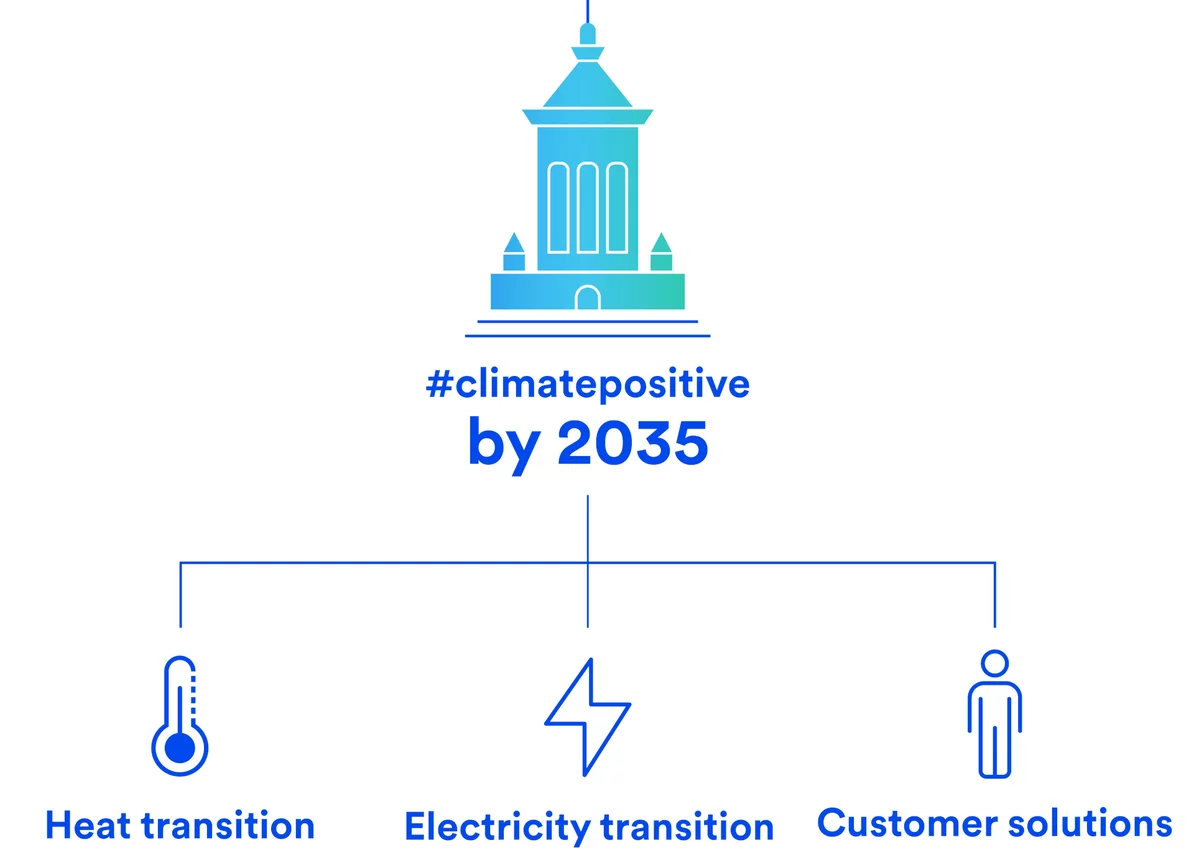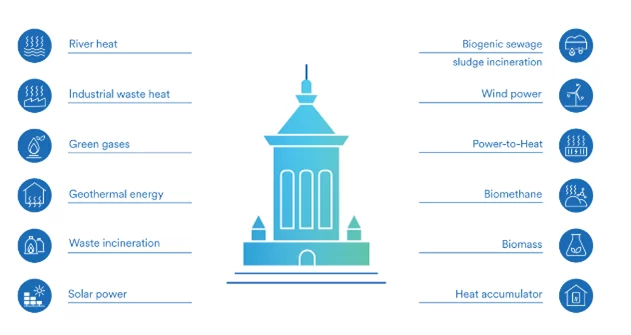The guiding framework for our #climatepositive course
We are pioneers of the energy transition. With our Mannheim Model, we have committed to a strategic course that will make us #climatepositive by 2035 – as one of the first energy companies in Germany. In this, we are consistently promoting the heat transition, the electricity transition and the associated expansion in renewable generation methods, as well as green solutions for our customers.

We base all our actions at the MVV Group on the Mannheim Model, which applies to all locations. As we head towards a #climatepositive future, we are fully converting our district heat generation in Mannheim and Offenbach to green energy sources by 2030. We will complete this conversion in Kiel, and thus at the whole of the Group, by 2035 when the gas-fired power plant there is operated with hydrogen. In addition, we will more than triple our electricity generation from renewable energies by 2030: from 633 megawatts currently to around 2,000 megawatts in 2030. We aim not only to become #climatepositive ourselves as a company, but also to support our customers with their own climate neutrality. To this end, by 2035 at the latest we will exclusively offer 100 percent climate-neutral products and services and gradually convert our existing customer contracts to green solutions.

We are making a reality of the heat transition
By 2030, we will make our district heat in Mannheim, the region and Offenbach 100 percent green. We will thus go well beyond the 50 percent requirement laid down by the Federal Government. Kiel is set to follow by 2035, once the state-of-the-art gas-fired CHP plant there is operated with hydrogen. By then, our district heat will be 100 percent green across the whole of the Group.
We see our heat transition activities at the Mannheim location as providing the blueprint for the whole process of making district heat generation green. In 2020, we implemented the first expansion stage for the heat transition in Mannheim by connecting our energy from waste plant. In 2024, we will complete the second stage of the transition in Mannheim. For this, among other measures, we have launched operations with our first river heat pump. By 2024, we will already be able to cover up to 60 percent of heat demand from households and businesses in Mannheim with climate-friendly heat. After that, we will start work on the third stage for reaching 100 percent green heat. This involves green technologies such as geothermal heat, additional river heat pumps, using further industrial waste heat, electrode boilers and biomethane CHP plants. And this conversion to 100 percent green heat naturally applies to our other major locations as well.
Heat grids also have to be prepared for this pathway to renewable heating. That is why we are increasing the density of existing grids and building targeted new infrastructure. This way, we will be able to make the widest possible use of green heat. We are eliminating parallel grid structures where possible. And we are strengthening our electricity grids so that they can cope with growing demand, especially from heat pumps.
Furthermore, we are expanding our range of decentralised heat solutions to enable those customers who cannot be connected to a district heat grid to have climate-friendly heating of their own. In addition, we are supporting local authorities in their plans for the heat transition.
We are accelerating the electricity transition
To implement the electricity transition, we have been expanding our proprietary renewable energies capacities for many years now. Our focus is on onshore wind power and photovoltaics. We will further accelerate our existing pace of adding new capacities and increase our installed renewable energies generation capacities to 2,000 MW by 2030.
To significantly expand our proprietary green generation portfolio, we intend to retain growing numbers of domestic wind and PV projects developed by our Juwi subsidiary within the Group. We will fully convert our remaining fossil-based generation to green energies by 2035. Moreover, we are increasingly supporting plant operators in revamping their turbines and thus optimising older facilities to enhance the performance capacity of existing windfarms. By implementing repowering measures in the years ahead, we will also replace increasing numbers of existing wind turbines with new, higher-performing models.
We are further expanding our climate neutrality solutions for customers
We aim to inspire our customers with the standard of our customer service and our portfolio of products and services, to convince them and to achieve high levels of customer satisfaction. We intend to support our customers in achieving their own climate neutrality. That is why we are gradually converting our products and services to 100 percent climate-neutral solutions by 2035. We already have a full range of products and services available to supply green energy.
We take a holistic view of the transformation in the electricity and heat supply and aim to provide our customers with implementation solutions from a single source.
We will be #climatepositive by 2035
One interim step as we head towards a #climatepositive future involves shrinking our total carbon footprint to net zero by 2035. We include all sources of greenhouse gases in our climate balance sheet, i.e. we also include sources in the upstream and downstream supply chains and at our shareholdings.
In addition, by working with BECCUS (Bioenergy Carbon Capture Usage and Storage) we will actively withdraw CO2 from the atmosphere and then permanently bind, use or store this gas. Based on the operating experience gained, we will gradually extend the use of this technology in our plant portfolio. This way, we will offset our own unavoidable residual emissions. Not only that: Thanks to the additional CO2 withdrawn from the atmosphere, our overall emissions will turn negative by 2035 already and we will become #climatepositive.


